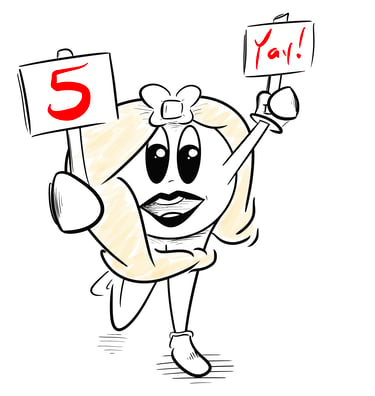
Rod-Land: Tawada's Symphonic Fairy Tale
Rod-Land Video Game Soundtrack
Composer: Tsukasa Tawada (Jaleco)
Produced/Directed: Yoshihiro Ohno, Takashi Okamoto
Scitron's G.S.M. 1500 Series
Rod-Land is one of those single-screen masterpieces most have never seen, let alone played. It defies the genre’s typical template, more contrasting than matching the likes of Bubble Bobble and Snow Bros., the standard bearers of a gameplay-style now regarded as largely passé. But Rod-Land was more than a set of unique mechanics. It was also the host to a surprisingly varied musical score—a mix of horn, string, and scintillating synth. A collection of melodies that, sadly, probably went unappreciated in the hustle and bustle of the usual Japanese arcade.
But someone must have noticed. Or rather, someone must have remembered. For, circa sometime 2006, the game received a CD soundtrack—one in a series of budget releases based on Jaleco’s most notable, nostalgic properties. Extremely nostalgic, in fact, for the company was nearing bankruptcy, enduring buyouts and spin-offs and split-ups across that first decade. By 2014, the once legendary company would be rendered defunct, its assets purchased by City Connection, an entirely separate studio.
Jaleco’s demise makes this niche release an especially obscure time capsule today, and triply-so for the rare Westerner interested in such a Japanese-centric experience. Although the disc itself is packed in rather no-frill fashion, it does come with a sticker card and, more interestingly, the sheet music to Rod-Land’s Episode 1 ending theme with notes from the esteemed composer himself, Mr. Tsukasa Tawada. Although too much to transcribe here, his opening lines are enlightening:
“Hey everyone! It’s ‘Rod-Land’…I tried to create a fantastic, symphonic poem with a melody and harmony emphasizing a sense of color.”
And that’s exactly what Rod-Land is—a game made fairy tale told with the same winsome whimsy of, say, Prokofiev’s Peter and the Wolf. And though the raw chiptune creations could never truly duplicate the latter’s symphonic grandeur, Tawada, by means of this release, gained the opportunity to try again via a new opening medley. This 10-minute retro-piece—titled (roughly) “The Country is Wide”—uses a collage of classical instrumentation to not only capture Rod-Land’s many ambient highlights, but to bolster them into full, symphonic triumphs. Through flute and clarinet, percussion and horn and strings of real feeling, he succeeds in demonstrating what the game always was: A journey of discovery and growing up; a journey of faith; a journey born of courage and love. It’s a fleeting but delightful romp that pays homage to both the game’s heritage and classical orchestration.
Tracks 2-24 are more conventional, of course, being the simple rips from the original game’s FM/PCM tunes. These pieces have never sounded better, of course, and still transcend their humble origins. But following Tawada’s initial, euphoric score, the vintage tunes can’t avoid feeling a little anti-climactic, like watching the last minutes of an exciting sports game first, only to then, out of duty, deciding to rewind and view the rest. The medley is so triumphant, one only yearns for more…a remake of Rod-Land itself, perhaps, along with a full, orchestral score! But considering the game’s perpetual obscurity, this is, at best, a wistful wish.
The Rod-Land soundtrack is difficult to find today, with a recent eBay search finding only one for an astounding $140.00. And though the soundtrack can also be found on Amazon and Apple marketplaces under the Clarice Disc label, it lacks that dreamy opening medley so vital to the entire package. That album is still well-worth the download, but without Tawada’s extra enhancement, outsiders might not fully comprehend why that “silly” single-screen platformer remains so beloved amongst those who still remember. And that's a pity.--DA
For those curious to hear Tawada’s brilliance, the full 9:33 recorded piece can be found here on YouTube. Thanks Saigononindou! Those wanting a track list with production credits should venture to this location.


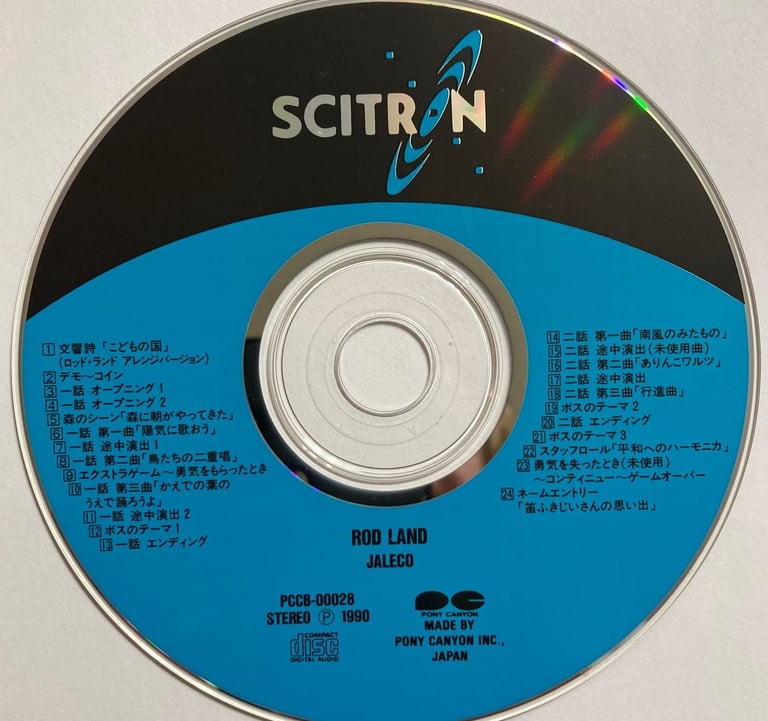

The CD comes with a sticker sheet that essentially duplicates the jewel case cover label. It's also, incidentally, the cover seen on the game's Nintendo Famicom release, among others.


The CD's skimpy two-page "booklet": it's solely ornamental with nothing written on the inside.
Imaginative Interpretations - Pondering Takashi's Master Medley, "The Symphonic Poem"
"The Country is Wide"
Tawada’s medley can be divided into three parts, or acts. The first two are the true, robust bodies of the work; the third is more akin to the final fade-out of an epic film, a tune both brief and fleeting, ebbing into the ether like a whispering goodbye. Below are my own interpretations of his work, although my lack of true musical training makes this more a subjective, instinctual exercise versus anything truly authoritative.
Having at least a passing familiarity with Rod-Land’s plot will also help with understanding and following the score’s many nuances. In short, young fairies Rit and Tam must scale the formidable “Maboots” Tower to rescue their kidnapped mother. It’s a formidable quest for those so young, but with Faith and Love in their hearts, the two are determined. And so begins their story…and their score.
Act 1
Tawada’s Symphonic Poem opens much how the game itself begins—with a burst of horn announcing its heroes and the precarious journey ahead. It’s an upbeat repeat of “Morning Comes to the Forest,” the intrepid, resolute melody that sees the two children off in their arcade adventure. It soon mellows into a murmuring simmer before a succession of flutes punctuate the soft proceedings, leading to another rising, triumphant call--as if the kids are actually thinking, “So, we’re actually doing this!”
The music mellows again, a mild interlude that suggests a sense of discovery, a journey slowly unfolding. A new melody, “Birds of Duet,” then takes hold, granting a stronger yet somehow more soothing vibe—a series of comforting, dainty beats not unlike the pitter-patter of the kids’ own scampering feet. The flutes return, sharpening the score with an increasing sense of urgency. It still connotes the same whimsy of its arcade rendition, “Let’s Dance on the Leaves of Maple,” but now comes with a steadier focus…suggesting the siblings are becoming more confident, getting more serious. And that progress is being made.
This culminates into a sudden, grandiose finale, forecasting, perhaps, that Rit and Tam have prevailed over their initial challenges, from droves of foes to their own anxieties and fears.
Act 2
Act 1’s boisterous conclusion segues immediately into a subdued, almost lazy, strum of strings—as if the two heroes are taking a wistful break and thinking back to happier, more innocent times. Will those sunny days ever return?
A series of “toots” breaks the reverie, broken only by the bumbling waddle of, perhaps, baddies on the march, a desperate, last-ditch regrouping meant to stop the fairy pair. A splash of euphoric sound intercepts this progression, providing a more elegant, heroic cadence meant to drown the awkward on/off plodding of before. It’s a remix reminiscent, again, of “Morning Comes to the Forest,” this time depicting a more demanding Rit and Tam rising righteously to meet their would-be opposition…mere children gathering their flagging strength for a harsh, final stand. It’s an energetic, celebratory reckoning that ends in seeming victory. But after a fitful crescendo, a contemplative beat takes command, a sober Sicilian-note of introspection—of remembrance, of love—which grips the siblings as they stare upon their mother’s abductor, a villain now powerless and at their mercy. What should they do? What would Mom want? What is the just, Godly path?
A sequence of bold, poignant horn relays the heroes’ final decision and lasting triumph. Their mother is saved…and their souls are safe. Good has been restored.
Act 3
With Rod-Land’s story now told, a harp plays its wispy haunts, a melancholic tribute to “Whistling Old Man of Memories” from the game’s name entry screen. Here, it serves as a wistful look back on a harrowing journey. Or, moreover, it plays as a dirge to childhood lost, duty and destiny taking its place.
What awaits Rit and Tam? The fans know. Happily or tragically, the two’s true journey has just begun.


The sheet music to Rod-Land's Episode 1 Ending theme. The extra message scrawled at the bottom definitely befits the game's hopeful tone--let there be peace across the cosmos, indeed!
CD Track Listings (Based on the Clarice Disc Label Descriptions)
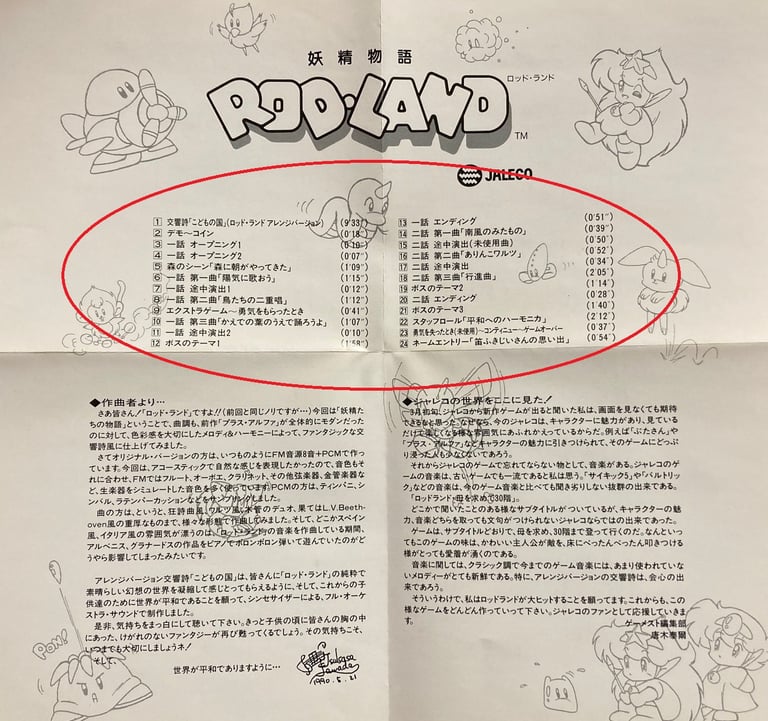

Rod-Land's 24 works as structured for this collection.
1. Symphonic Poem—The Country is Wide
2. Demo, Coin
3. Ep1 [SIC?] Opening1
4. EP.1 Opening2
5. Forest Scene “Morning Came to the Forest”
6. EP.1 First Song “Let’s Cheerfully Sing”
7. EP.1 The Way Production 1
8. EP.1 Second Song “Birds of Duet,” plus sound effect
9. “Extra Game,” plus sound effect, “When I Got the Courage,” plus sound effect
10. EP.1 Third Song “Let’s Dance on the Leaves of Maple”
11. EP.1 Middle Directing 2
12. Boss Theme 1, plus random sound
13. EP. 1 Ending
14. EP. 2 First Song “What I Saw of the South Wind”
15. EP. 2 The Way Production (Unused Song)
16. EP. 2 Second Song “Arriko Waltz”
17. EP. 2 The Way Production
18. EP. 2 Third Song “March”
19. Boss Theme 2, plus sound effect
20. EP. 2 Ending
21. Boss of the Theme 3, plus sound effect
22. Staff Roll “Harmonica to (of) Peace”
23. “When I Lost the Courage (Unused Song),” “Continue,” “Game Over” Name Entry “Whistling Old Man of Memories”
Translating Tawada-san: Below is a (Google) translation of both his and Mr. Karaki's wistful words. I did my best to touch-up the phrases still tricky to fully decipher; my apologies for any mistakes!
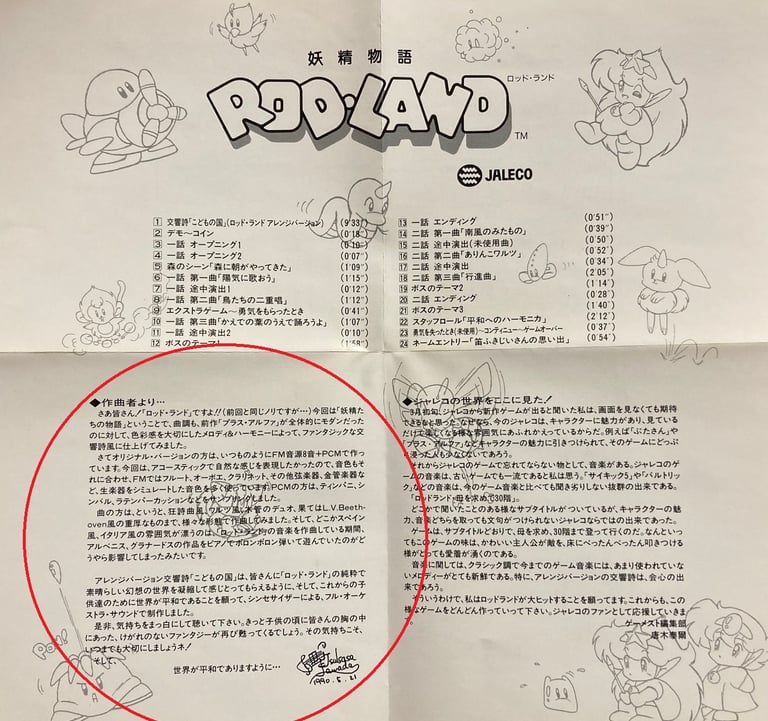

Mr. Tawada's personal note--it's surprisingly essential to fully understanding the work at hand.
Left Column: Tsukasa Tawada
Hello everyone! It’s Rod-Land! In part, I tried to create a fantastic symphonic poem with a melody and harmony that emphasizes the sense of color.
Well, the original version is made with 8 FM sound sources + PCM as usual. This time, I wanted to express an acoustic and natural feeling, so I used many sounds that simulated live instruments such as flutes, oboes, clarinets, and other stringed and brass instruments. For PCM, we sampled timpani, cymbals, Latin percussion, etc.
As for the music, I tried composing in various forms, from rhapsody-style, Wurtz-style, parallel woodwinds, and even L.V. Beethoven-style. And the somewhat Spanish and Italian atmosphere is probably influenced by the period when I was [originally?] composing the music of "Rod-Land," playing Albéniz and Granados' works on the piano. I think that’s [remembered] correct.
The arranged version of the symphonic poem "Kodomo no Kuni" [Children’s Country or The Country is Wide] is intended to distill the world of Rod-Land's pure and wonderful fantasy into a condensed whole, and to hope that the [real] world will be peaceful for the children of the future. With that in mind, I created a full orchestral sound using a synthesizer.
Please listen with an open mind. Let it revive that pristine child-like sense of wonder and fantasy still dwelling in your heart. Let's cherish that feeling forever!
May the world be peaceful... 1990.5.21
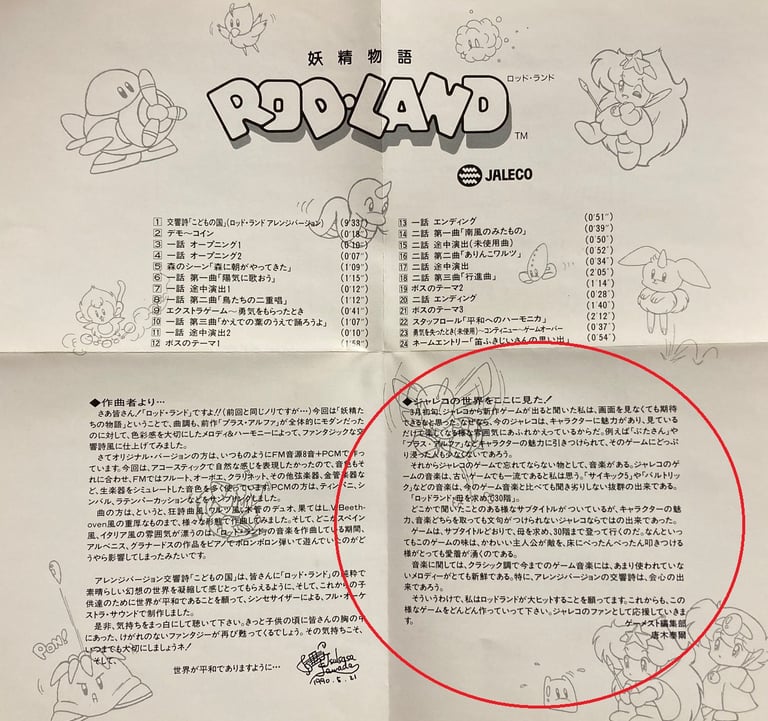

Taiji Karaki--obviously a Jaleco fan--adds his own thoughts. His full identity and role in this production, however, isn't clear, but he definitely understands the richness of Jaleco's musical history.
Right Column: Taiji Karaki
I saw the world of Jaleco here!
In early March, when I heard that a new game was coming out from Jaleco, I thought I could look forward to it without looking at the screen [video game sprites of the characters?]. The reason is that the current Jaleco has attractive characters and is overflowing with an atmosphere that makes it fun just to look at it. For example, there are probably more than a few people who have been immersed within the game due to the charms of characters such as “Buta-san” and “Plus Alpha.”
Then there's Jaleco’s unforgettable music. I think the music in Jaleco games is top-notch even for the older titles. “Psychic 5” and “Valtric” contain outstanding performances that are not inferior to modern game music.
"Rod-Land: Thirty Floors in Search of Mother." That subtitle seems familiar, but the characters’ charms and powerful performances are unique to Jaleco, making complaint impossible. As the title suggests, the game entails climbing to the 30th floor in search of your mother. Indeed, the game’s appeal is that the cute protagonist can slam enemies across the floor. This engenders a sense of endearment and attachment within the player.
As for the music, it has a classical, melodic style not commonly found in gaming. It still feels very fresh. In particular, this arranged version of the symphonic poem will be regarded as a satisfying achievement.
That's why I wish Rod-Land to be a big hit. Please continue making games like this. As a Jaleco fan, I will support you.
Games Editorial Department,
Taiji Karaki
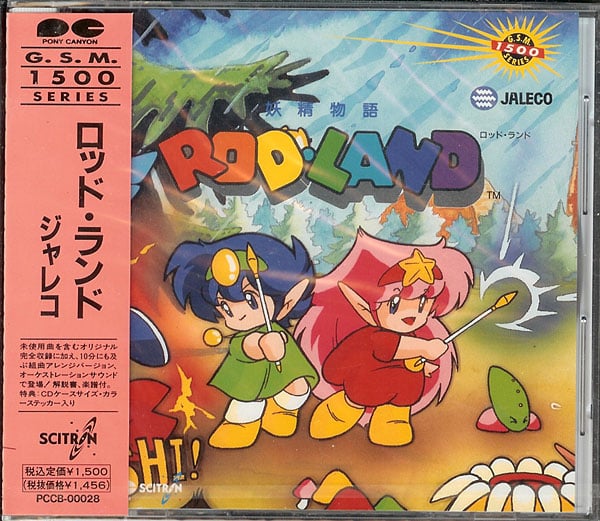

Front
A still-sealed copy of the soundtrack as it would have been seen in Japan (probably around) 2006. Thanks to downloads.khinsider.com for the pic.


Back
The jewel case's backside artwork.
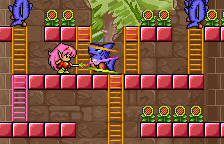

For those still wondering, the game itself is named after the wand Rit (the girl to the right) and Tam (her brother) use to trap and whap their foes. Here, Rit has an enemy temporarily ensnared.
Thanks to hardcoregaming101.net for the image.
